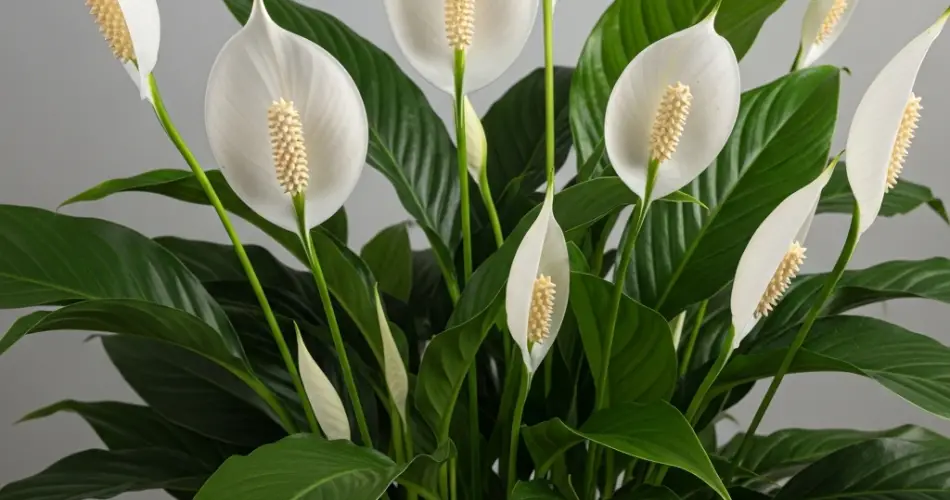Spathiphyllum, also known as the peace lily, is a popular houseplant thanks to its elegant white blooms and air-purifying qualities. While it’s generally easy to care for, many plant owners find themselves struggling when it comes to encouraging their spathiphyllum to flower. Even with regular watering, proper lighting, and occasional fertilization, the plant sometimes stubbornly refuses to bloom.
However, an unusual but surprisingly effective trick has emerged from the world of DIY plant care: using a simple, inexpensive pharmaceutical tablet to stimulate flowering. It might sound strange, but one pill could be the secret to making your peace lily burst into bloom.
The Secret Ingredient: Suprastin
The tablet in question is Suprastin, a common antihistamine used to treat allergies in humans. While its use in plant care might seem unconventional, some gardening enthusiasts have discovered that a diluted Suprastin solution can have a noticeable effect on plant vitality—particularly when it comes to flowering.
It’s important to note that this isn’t a scientifically proven method, but anecdotal evidence from hobbyists suggests that the pill works like a tonic, encouraging lush, green foliage and triggering the blooming cycle in peace lilies. The results have genuinely surprised many who have tried it.
Why Might This Work?
While there is no direct research linking antihistamines to plant growth, some speculate that certain compounds in medications like Suprastin might affect root development or interact with soil microbiota, indirectly promoting flowering. It could also be that the tablet contains auxiliary ingredients—like sugars or binders—that enrich the soil in a subtle way.
Whether it’s the active ingredient or something else in the pill, the outcome remains impressive: peace lilies that haven’t bloomed in months—or even years—suddenly produce fresh, elegant flowers after treatment.
How to Use the Suprastin Method on Your Peace Lily
If you’re curious to try this method for yourself, here’s a simple, step-by-step guide:
-
Choose a Healthy Plant
Ensure your peace lily is in generally good condition. The leaves should be mostly green, with no major signs of disease, pest infestation, or severe dehydration. This method is not a cure for an unhealthy plant—it’s a stimulant for one that’s stable but dormant. -
Prepare the Solution
Take one Suprastin tablet and dissolve it in one liter of warm, settled water. Stir until the tablet is fully dissolved. It’s best to use room-temperature water that has been allowed to sit for 24 hours, as this removes chlorine and other potentially harmful substances. -
Water Your Plant
Pour the solution into the soil at the base of the peace lily, just as you would during a normal watering session. Make sure the soil is moist but not waterlogged. Avoid splashing the leaves. -
Repeat Only Occasionally
This isn’t a routine fertilizer, so do not use it frequently. One treatment is enough to trigger results, and you should wait at least 6-8 weeks before considering a second application—if any. Overuse may do more harm than good. -
Observe and Wait
Within 2–4 weeks, you may notice increased leaf vitality, a stronger green color, and new flower stalks beginning to form. Be patient and avoid over-fertilizing in the meantime.
Additional Tips to Encourage Flowering
While the Suprastin method is certainly intriguing, it works best in combination with good care practices. Here are a few things to keep in mind:
-
Lighting: Spathiphyllum prefers bright, indirect sunlight. Avoid direct sun, which can scorch the leaves.
-
Watering: Keep the soil consistently moist, but don’t let it sit in water. Peace lilies are sensitive to both overwatering and underwatering.
-
Humidity: These tropical plants love humidity. Mist the leaves regularly or place the pot on a humidity tray.
-
Repotting: A root-bound peace lily is more likely to bloom. If the roots are tightly packed, consider moving the plant to a slightly larger pot to refresh the soil.
Final Thoughts
The use of a simple antihistamine tablet to stimulate blooming in spathiphyllum may sound like an urban gardening myth—but those who’ve tried it are often amazed at the outcome. While it’s not a substitute for consistent plant care, it can be an effective trick to try when your peace lily refuses to flower despite your best efforts.
This method is low-cost, easy to try, and could be just the solution you need to bring your peace lily back to life with beautiful white blooms. If you’re dealing with a stubborn plant, why not give it a try?



